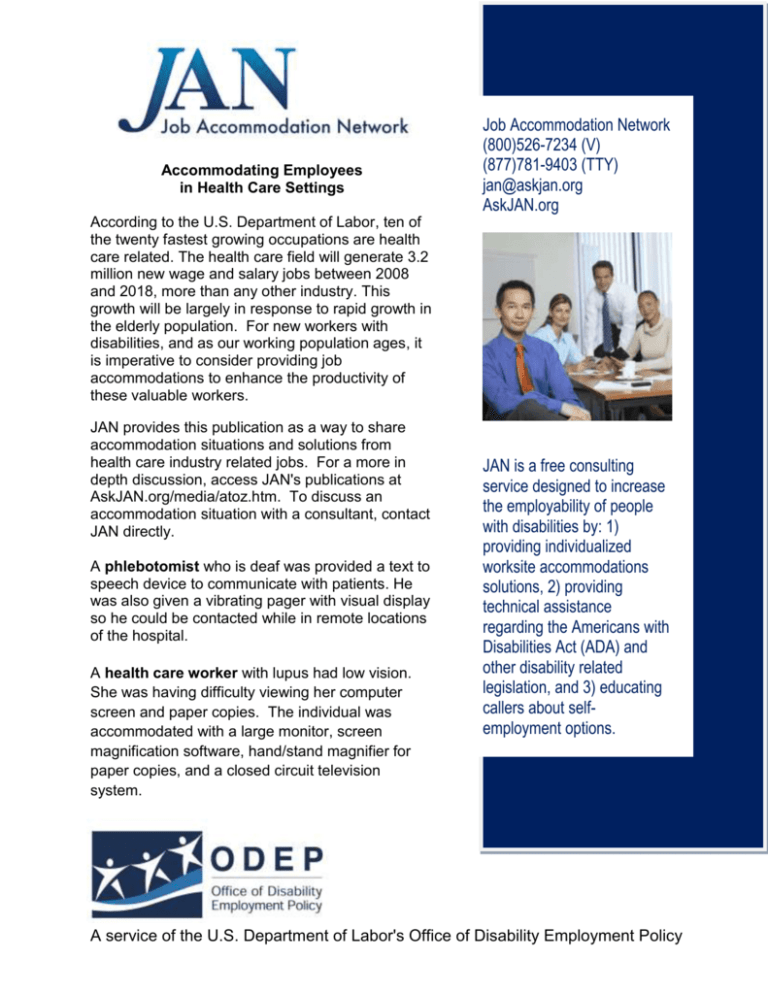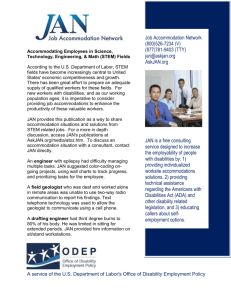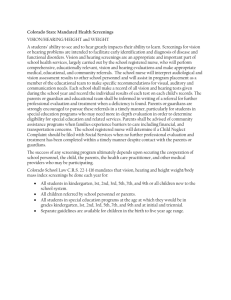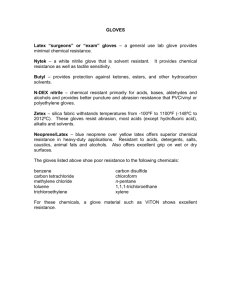Health Care Settings - Job Accommodation Network
advertisement

Accommodating Employees in Health Care Settings Job Accommodation Network (800)526-7234 (V) (877)781-9403 (TTY) jan@askjan.org AskJAN.org According to the U.S. Department of Labor, ten of the twenty fastest growing occupations are health care related. The health care field will generate 3.2 million new wage and salary jobs between 2008 and 2018, more than any other industry. This growth will be largely in response to rapid growth in the elderly population. For new workers with disabilities, and as our working population ages, it is imperative to consider providing job accommodations to enhance the productivity of these valuable workers. JAN provides this publication as a way to share accommodation situations and solutions from health care industry related jobs. For a more in depth discussion, access JAN's publications at AskJAN.org/media/atoz.htm. To discuss an accommodation situation with a consultant, contact JAN directly. A phlebotomist who is deaf was provided a text to speech device to communicate with patients. He was also given a vibrating pager with visual display so he could be contacted while in remote locations of the hospital. A health care worker with lupus had low vision. She was having difficulty viewing her computer screen and paper copies. The individual was accommodated with a large monitor, screen magnification software, hand/stand magnifier for paper copies, and a closed circuit television system. JAN is a free consulting service designed to increase the employability of people with disabilities by: 1) providing individualized worksite accommodations solutions, 2) providing technical assistance regarding the Americans with Disabilities Act (ADA) and other disability related legislation, and 3) educating callers about selfemployment options. A service of the U.S. Department of Labor's Office of Disability Employment Policy A physician with muscular dystrophy was having problems getting up from a seated position after consulting with patients. The individual was accommodated with a lift cushion for his chair. A resource nurse with multiple sclerosis was having difficulty accessing her workstation. Her employer widened the floor space at her workstation to allow her easier access from her wheelchair and added an adjustable keyboard tray, monitor holder, and telephone tray. A nurse with a hearing impairment worked the night shift and had to talk to doctors who called for information. She was having difficulty hearing over the telephone. The employee asked to be moved to a dayshift where there would be other nurses who could talk to the doctors; however, there were not any openings on the dayshift. The employer purchased a telephone amplifier, which enabled the nurse to hear effectively over the telephone. A medical technician who was deaf could not hear the buzz of a timer, which was necessary for specific laboratory tests. An indicator light was attached to the equipment. A pharmacy technician with carpal tunnel syndrome who was having difficulty opening vials of medication, placing orders into bags, and sealing the bags was accommodated with a jig to hold the vials of medication in place, an assistive bottle opener, and an electric stapler. A social worker with arthritis in her hands was having difficulty reading case summaries, manipulating paperwork, and taking notes. She was accommodated with a page turner, bookholder, writing aids, and the option to dictate reports to her clerical staff. A pharmacist technician with multiple sclerosis needed to use a wheelchair but could not reach the counters and shelves in the pharmacy. He was accommodated with a stand-up wheelchair. A nurse with bilateral hearing loss had been using an amplified stethoscope that required her to remove her hearing aids. A stethoscope that could be used with the direct audio input port of her hearing aid was purchased, and she no longer needed to remove the hearing aids. A pharmacist with HIV was having difficulties standing to fill prescriptions for eight hours a day on a tile floor. The work area was carpeted using extra padding, which assisted in reducing fatigue, and a sit/stand/lean stool was purchased to assist the employee when standing. He was also permitted to adjust his schedule with a reduced lunch so he could take frequent rest breaks throughout the day. A registered nurse with latex allergies was having difficulty wearing latex gloves. The employer provided her with non-latex gloves and started using non-powdered latex gloves for other staff to reduce the amount of latex in the environment. A mental health counselor with a below-the-elbow amputation needed to use the computer to access health records and document meetings with clients. The employer purchased a one-handed keyboard, speech recognition software, and training for both.







